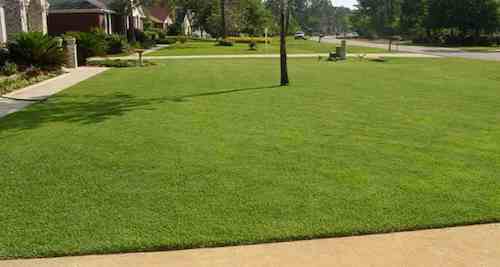
EMPIRE is a blue-green turfgrass that has a wider blade than most other zoysias (slightly broader than Meyer Zoysia) and grows in a wide variety of soil and climate conditions. EMPIRE performs well in sandy and clay type of soils throughout the southern U.S. and has tough runners, rhizomes, and deep roots that provide excellent sod strength, wear ability, and improved drought tolerance. EMPIRE performs well in hot, arid, sandy sandy areas of the southeast U.S., and has proven itself drought tolerant in many challenging applications.
Bladed
to Thrive
- Blade-width: 5-7mm
- Color: Blue-Green
- Very Soft Feel
- Very Good Wear Tolerance
- Very Good Injury Recovery
- Very Good Drought Tolerance
- Very Good Disease & Insect Resistance
- Good Shade Tolerance (4-5 hrs)
- Very Good Fall Color Retention
Maintenance
Proper watering upon installation is essential to successful establishment.

Water thoroughly upon installation ensuring that both the EMPIRE is wet and the soil is moist to a depth of 3", which is approximately 1" of water per day. In hot weather, water within a few hours of installation to mitigate severe damage or loss due to heat/dehydration stress. Shaded areas and heavy soils require less water than full-sun areas and sandy soils. When proper rooting is evident, alter irrigation program accordingly.
MOWING: New installations are often uneven and care should be taken not to scalp high spots:
Mow within 10 days of installation and bag clippings for the first few mowings
After the first few mowing see post establishment instructions for proper mowing practices
Once your new lawn is rooted follow the chart below.
Mow when grass is this tall: 2" 5cm
Set cutting height of mower to: 1.5" 3.7cm
FERTILITY: Use a transplant-friendly regimen that will help reduce shock and minimize disease
Use a starter fertilizer that is low in nitrogen and higher in phosphorous and potassium
For best results always perform a soil test and fertilize accordingly
More on MOWING: Mowing is a critical and often under appreciated cultural practice:
Maintain EMPIRE at 1-2"
Heights above 2" will reduce quality
Can be maintained at heights of 1/2" if regularly mowed with reel mower
Rotary mowers are preferred for heights 1" or higher
Reel mowers are preferred for heights below 1"
Mow every 7-10 days during the active growing season
Mow every 10-14 days, or as needed, during cooler weather
Never cut more than 1/3" of the total length of the blade at any one mowing
If a scheduled mowing is missed and clippings clump on top of the EMPIRE, bag or vacuum clipping to reduce shade-out
Vertical mowing (verticutting) may be performed to renovate EMPIRE
|
Zoysia Grass Comparison Testing |
|||||||||||||||
|
Grass Type |
Overall Quality |
Color |
Spring Green Up Rating |
Leaf Texture (NC) |
Spring Density Rating (NC) |
Summer Density Rating (NC) |
Fall Density Rating (NC) |
Spring % Living (NC) |
Fall % Living (NC) |
Dollar Spot Rating (NC) |
September Color Rating |
October Color Rating |
November Color Rating |
December Color Rating |
Minimum hours of Sunlight |
|
Empire |
57% |
67% |
47% |
70% |
60% |
70% |
77% |
89.70% |
98.30% |
63% |
60% |
53% |
50% |
23% |
5 |
|
Zeon |
56% |
63% |
43% |
80% |
70% |
70% |
80% |
61% |
99% |
40% |
60% |
57% |
53% |
37% |
4 |
|
Meyer |
49% |
57% |
63% |
70% |
50% |
57% |
67% |
86% |
97.70% |
77% |
63% |
60% |
53% |
27% |
5 |
|
Emerald |
77% |
73% |
N/A |
80% |
83% |
77% |
73% |
66.70% |
N/A |
73% |
N/A |
73% |
57% |
N/A |
4 |
More info:
Empire Zoysia is Zoysia japonica (commonly known as Korean lawngrass, zoysiagrass or Japanese lawngrass) is a species of creeping, mat-forming, short perennial grass that grows by both rhizomes and stolons. It is native to the coastal grasslands of southeast Asia and Indonesia. The United States was first introduced to Z. japonica in 1895. It received its first import from the Chinese region of Manchuria. Today, Z. japonica has become one of the most widely used species of turfgrass in the United States, serving as a close alternative to bermudagrass.
Zoysia japonica has smooth, stiff, vertical leaf blades that roll in the bud. It grows to around 0.5 mm in width, and is hairy near the base and exhibits short inflorescences. The pedicles grow to about 1.75 mm, while the ascending culm internodes measure to roughly 14 mm long. Z. japonica has a very coarse texture, compared to others of its genus. Its high tolerance to drought, freezing temperatures, salt, and shade make for a favorable lawn grass. An adventitious root system grounds the grass. When exposed to prolonged drought, it easily adapts by developing deeper rooting systems. Although it is tolerant to freezing temperatures, it does lose its bright green color, turning brown after frost.